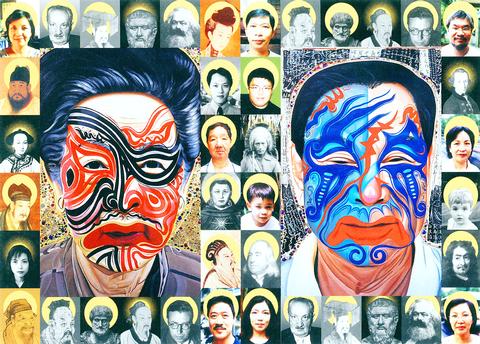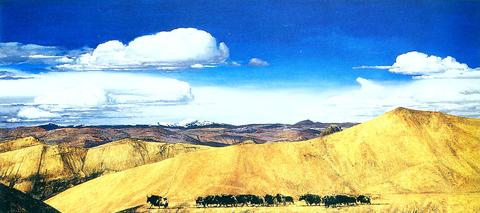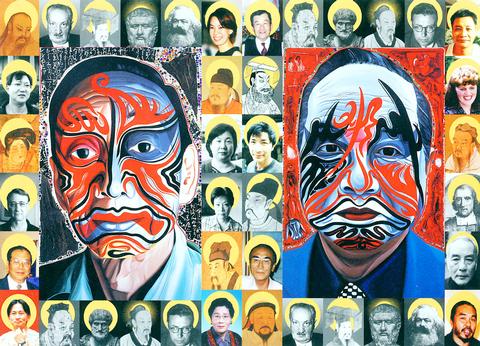In response to the light foot traffic that flows through Taiwan's art galleries, the Taipei Art Fair is a chance for these organizations to combine their strengths for a one-off major show at the World Trade Center. The result is not unlike a garage sale, where you can find a bit of everything, except the items here are sometimes priced in the millions of New Taiwan dollars.
With their differing specialties, the 26 participating galleries bring a dizzying range of artwork to the show, including works by early 20th-century Taiwanese impressionists, modern ink paintings by Zhang Da-qian (

PHOTO COURTESY OF GALERIE PIERRE
One of the quirky highlights of the show will be Shanghai conceptual artist Zhou Tiehai's (

PHOTO COURTESY OF SAN HSI ART GALLERY
The purpose of the show, beyond selling the galleries' works, is to liven up the art-viewing experience by inviting artists, such as Zhou and Max Liu (
The show will also include a mini-auction described by organizers as being "for beginners" with low-priced items tomorrow and Sunday. As a first in Taiwan, the auction can also be accessed via the Internet at http://www.aga.org.tw. Outside the main venue will be a flea market selling a range of handmade decorative items, clothes and gifts.

Another step taken to bring art to a broader public has been to invite people to submit their collections of random items to be arranged by installation artist Chiang Yang-huei (
The fair is a unique opportunity to see many of the most recent works by some of Taiwan's leading artists. One of the most arresting new pieces is the massive Totem and Taboo by J.C. Kuo (
In an entirely different style, Ma Yuan's (馬元) The Top of the World Mountains is a stunning realist landscape of Tibet with a herd of yaks crossing a desert plateau.
The show also includes works by several prominent Western painters, including Paul Cezanne, Pablo Picasso and Pierre-Auguste Renoir.
With its wild mix of painters and styles, the Taipei Art Fair may leave viewers disoriented from the show's lack of theme, but its success is in saving the public the hassle of visiting each gallery individually. Here, the galleries' best pieces are assembled in one location in a festive atmosphere entirely unlike the typical museum exhibition.

Nov. 11 to Nov. 17 People may call Taipei a “living hell for pedestrians,” but back in the 1960s and 1970s, citizens were even discouraged from crossing major roads on foot. And there weren’t crosswalks or pedestrian signals at busy intersections. A 1978 editorial in the China Times (中國時報) reflected the government’s car-centric attitude: “Pedestrians too often risk their lives to compete with vehicles over road use instead of using an overpass. If they get hit by a car, who can they blame?” Taipei’s car traffic was growing exponentially during the 1960s, and along with it the frequency of accidents. The policy

While Americans face the upcoming second Donald Trump presidency with bright optimism/existential dread in Taiwan there are also varying opinions on what the impact will be here. Regardless of what one thinks of Trump personally and his first administration, US-Taiwan relations blossomed. Relative to the previous Obama administration, arms sales rocketed from US$14 billion during Obama’s eight years to US$18 billion in four years under Trump. High-profile visits by administration officials, bipartisan Congressional delegations, more and higher-level government-to-government direct contacts were all increased under Trump, setting the stage and example for the Biden administration to follow. However, Trump administration secretary

The room glows vibrant pink, the floor flooded with hundreds of tiny pink marbles. As I approach the two chairs and a plush baroque sofa of matching fuchsia, what at first appears to be a scene of domestic bliss reveals itself to be anything but as gnarled metal nails and sharp spikes protrude from the cushions. An eerie cutout of a woman recoils into the armrest. This mixed-media installation captures generations of female anguish in Yun Suknam’s native South Korea, reflecting her observations and lived experience of the subjugated and serviceable housewife. The marbles are the mother’s sweat and tears,

In mid-1949 George Kennan, the famed geopolitical thinker and analyst, wrote a memorandum on US policy towards Taiwan and Penghu, then known as, respectively, Formosa and the Pescadores. In it he argued that Formosa and Pescadores would be lost to the Chine communists in a few years, or even months, because of the deteriorating situation on the islands, defeating the US goal of keeping them out of Communist Chinese hands. Kennan contended that “the only reasonably sure chance of denying Formosa and the Pescadores to the Communists” would be to remove the current Chinese administration, establish a neutral administration and